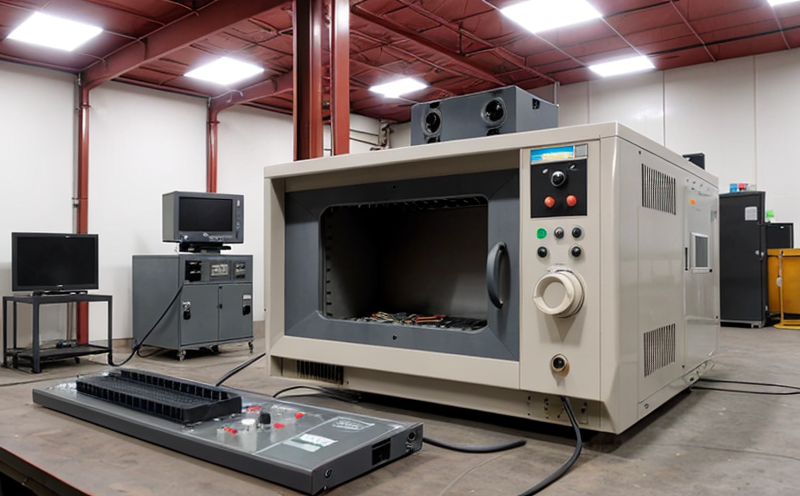ETSI EN 301 489 EMC Testing for Industrial Wireless Devices
The ETSI EN 301 489 standard is a critical component in the development and certification of industrial wireless devices. This European standard, published by the European Telecommunications Standards Institute (ETSI), ensures that all wireless communication systems adhere to electromagnetic compatibility (EMC) requirements. EMC testing aims to ensure that electronic products do not cause harmful interference to other devices within their operational environment.
Industrial wireless devices are used in a wide range of applications, including automation and control systems, remote monitoring, and process management in manufacturing environments. These devices must perform reliably under various electromagnetic conditions without causing interference or being affected by it. The ETSI EN 301 489 standard ensures that these requirements are met through rigorous testing protocols.
The scope of this test includes the evaluation of emissions from the device and its susceptibility to external interference. It covers both conducted and radiated emissions, as well as immunity tests against conducted and radiated disturbances. The testing process is designed to ensure that industrial wireless devices operate safely and effectively in their intended environments without causing harmful interference.
In terms of methodology, the test involves several key steps. First, the device under test (DUT) must be properly configured according to the standard's specifications. This includes setting up the DUT with all necessary accessories and ensuring that it is powered correctly. The next step is to perform emissions testing using appropriate equipment such as an anechoic chamber for radiated emissions or a Faraday cage for conducted emissions.
After measuring the emitted electromagnetic interference, the device must undergo immunity testing to ensure that it can withstand external interference. This includes both conducted and radiated immunity tests. Conducted immunity is tested by applying a specific signal through the power supply lines, while radiated immunity is assessed using an antenna placed near the DUT.
The results of these tests are then analyzed against predefined acceptance criteria outlined in ETSI EN 301 489. Compliance with these criteria ensures that the device meets all necessary EMC requirements. Non-compliance may result in rework or failure to obtain certification, which can significantly impact product development timelines and costs.
The importance of EMC testing cannot be overstated, especially for industrial wireless devices used in safety-critical applications such as medical equipment or automotive systems. Ensuring that these devices meet the strictest standards helps protect both end-users and manufacturers from potential risks associated with non-compliant products.
Compliance with ETSI EN 301 489 is essential for manufacturers who wish to enter European markets, where this standard is widely recognized. By adhering to these stringent requirements, companies can build trust with customers and regulators alike, thereby enhancing brand reputation and market access opportunities.
Scope and Methodology
The scope of ETSI EN 301 489 EMC Testing for Industrial Wireless Devices covers several key aspects of electromagnetic compatibility. It includes the evaluation of emissions from the device and its susceptibility to external interference. This testing ensures that industrial wireless devices operate safely and effectively in their intended environments without causing harmful interference.
- Conducted Emissions: Measurement of electrical signals transmitted through conductors, such as cables or power lines.
- Radiated Emissions: Measurement of electromagnetic waves emitted by the device itself. This is typically done using an anechoic chamber to simulate real-world conditions.
- Conducted Immunity: Assessment of how well the device can function when exposed to conducted interference, such as noise on power lines.
- Radiated Immunity: Evaluation of a device's ability to operate correctly despite being subjected to radiated electromagnetic interference from other sources.
The methodology for performing these tests follows strict guidelines set forth in ETSI EN 301 489. Compliance with these standards is crucial for ensuring that industrial wireless devices meet all necessary EMC requirements. Failure to comply could lead to rework or even failure to obtain certification, which can significantly impact product development timelines and costs.
Why Choose This Test
- Ensures Compliance with European Standards: Meeting the requirements of ETSI EN 301 489 is essential for manufacturers who wish to enter or maintain a presence in the European market.
- Promotes Product Reliability and Safety: By ensuring that industrial wireless devices meet stringent EMC standards, this test helps protect both end-users and manufacturers from potential risks associated with non-compliant products.
- Enhances Brand Reputation: Adhering to these strict requirements builds trust with customers and regulators alike, enhancing brand reputation and market access opportunities.
- Avoids Regulatory Penalties: Non-compliance can result in significant penalties, including fines and product recalls. Ensuring compliance avoids these costly issues.
- Facilitates Product Development: By identifying potential problems early on, this test allows manufacturers to address issues before they become more expensive or time-consuming later in the development process.
- Improves Customer Satisfaction: Reliable and interference-free devices lead to higher customer satisfaction rates, which can translate into repeat business and positive word-of-mouth recommendations.
- Promotes Global Trade: Compliance with European standards opens up new markets for manufacturers looking to expand internationally. It also helps maintain existing market positions by ensuring product quality remains consistent across different regions.
Choosing ETSI EN 301 489 EMC Testing not only ensures that industrial wireless devices meet the highest standards but also provides peace of mind for manufacturers and end-users alike.





